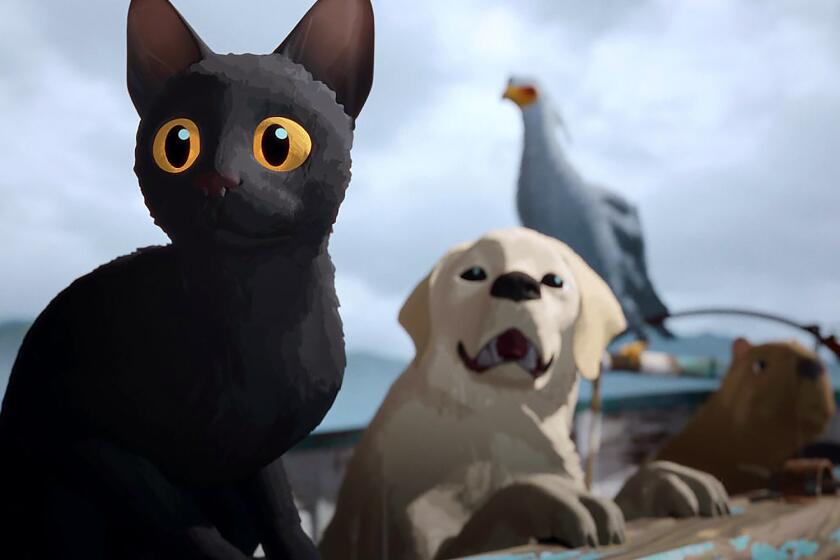Old pros backing up the old pro
In most youth-oriented Hollywood circles they would probably be considered âThe Over the Hill Gang,â but to Clint Eastwood they are the go-to team he counts on whenever he makes a movie: cinematographer Tom Stern, editor Joel Cox, stunt coordinator Buddy Van Horn and production designer Henry Bumstead. Stern is the baby of the group at 58; Bumstead will turn 90 next month.
âWorking with Clint is like the old studio days,â says Bumstead, an Oscar winner for 1962âs âTo Kill a Mockingbirdâ and 1973âs âThe Sting.â
âWhen you were part of a major studio, you knew everyone and you worked with everyone. This is the same thing. Clint doesnât do anything for two or 2 1/2 years, and once you go back [to work], everybody you worked with before is there. Itâs like a reunion. Clint likes to have people around him that he knows and works with.â
Bumstead, who was diagnosed with prostate cancer before production began on âMillion Dollar Baby,â was able to work on the film while receiving treatments because Eastwood supplied a wheelchair and car with a driver to make it easier for him. âI wouldnât have worked this long now if I hadnât gone back with Clint,â says Bumstead, who began collaborating with Eastwood on 1992âs âUnforgiven.â Like the rest of the Eastwood regulars, he comes across by phone as an unjaded regular Joe whoâs fiercely loyal to his boss -- and loves his job.
âHe gives me great freedom, so itâs fun working with him,â offers Bumstead.
Van Horn, 75, worked a few days as a stuntman on the 1968 Eastwood vehicle âCooganâs Bluff.â That filmâs director, Don Siegel, asked Van Horn to work on Eastwoodâs âTwo Mules for Sister Sara.â
âThat was the first one I worked all the way through with him,â says Van Horn. âWe had worked together way back at Universal in the 1950s, but we didnât know each other.â Eastwood, says Van Horn, âchecks people out pretty good,â and the two became âcordialâ on âTwo Mules.â On the next Eastwood film, âJoe Kidd,â he recalls, the producer informed Van Horn that the actor wanted him to be available to work on his subsequent projects.
Eventually Eastwood gave Van Horn the opportunity to direct three of his films.
âHe encourages you.... I did some second-unit directing for him and we did a comedy -- one of the monkey movies -- and then when they did the second one (1980âs âAny Which Way You Canâ) he said, âDo you want to do this?â I never considered [directing]. But [the film] was easy, so it was fun.â
Van Horn went on to direct two more Eastwood vehicles, 1988âs âThe Dead Poolâ and 1989âs âPink Cadillacâ before he returned to stunt coordination.
âHe makes you want to do good for him,â says Van Horn. âYou want to make him happy. I feel bad for a lot of people who have never been able to work with the man.â
Familiar faces
Like Bumstead, Van Horn works only for Eastwood these days. âI am one of the dinosaurs around here,â he says, laughing. âI like working with Henry Bumstead because he makes me not the oldest guy in the company!â
Peruse the crew list of âMillion Dollar Babyâ and youâll find that more than 30 members of the production crew have worked with Eastwood on two or more films, a phenomenon unparalleled in todayâs Hollywood.
Sure, editor Michael Kahn works exclusively for Steven Spielberg, and several other filmmakers -- including Martin Scorsese, Woody Allen and Alexander Payne -- have had longtime collaborators, but Eastwoodâs posse is unmatched. Since 1975, his production company, Malpaso, has maintained an office at Warner Bros.
âTo me itâs almost like a repertory company,â says Stern, the cinematographer. âIt is almost like when you get together for the spring play every year. I donât spend my time socially with Clint, though we are in constant touch [on projects].â
In the course of directing more than 20 feature films, starting with 1971âs âPlay Misty for Meâ (heâs in pre-production for No. 26, âFlags of Our Fathersâ), Eastwood has developed a visual style thatâs stark, simple and often a little ragged around the edges, much like the characters that inhabit the films.
He shoots his films fast and frugally -- the 39-day shoot for âMillion Dollar Babyâ began in June, and, says editor Cox, a print was available for screening by mid-November. Budget: approximately $30 million (contrast that with Martin Scorseseâs $110-million âThe Aviatorâ).
Eastwoodâs quick-and-cheap ethos, says film historian Gary J. Prebula, means that micromanagement is not part of the directorâs vocabulary. âNot at the speed he moves, so he has to macro manage. He has to pick the people that he knows what they are going to do and let them do their jobs. Itâs all about getting the job done efficiently and quickly as possible.
âThe big thing is that Clint Eastwood knows what he wants, and he makes the decisions. When you know what you want [as a director], it is infectious to work with somebody like that. You donât have to waste your time thinking what do [the directors] want. If someone is very up front and open, your job is wonderfully easy and, importantly, fun. I suspect that these people enjoy what they are doing.â
On an Eastwood set, says Prebula, âI think his goal is to go home. Age equals knowledge to him, and you do find that people who are in the business for that length have an extraordinary amount of knowledge and hence can do it faster.â
Passing muster
Cox, 62, began working with Eastwood as an assistant editor on 1976âs âThe Outlaw Josey Wales.â Ferris Webster, one of Coxâs mentors, was the official editor on the western.
âWhat happened is that Ferris got sick and I finished the last editing on the picture with Clint. That is when our relationship started,â says Cox. âHe just watched my work and he had a confidence in me. I was a young guy coming up. He is very savvy about filmmaking, and he understands just about everybodyâs job. He just watched me like a hawk. I think he realized I pretty much knew what I was doing.
âObviously, he saw something in me, and after that film he said, âI am hoping you donât have any plans. I would like you to be on our next film.ââ
Cox, who received an Oscar for editing âUnforgivenâ and is nominated for âMillion Dollar Baby,â has worked exclusively for Eastwood since 1982. âIn all the years I worked for him, only one scene have I taken apart,â Cox says. âIt was a scene in âSudden Impact.â Other than that, I have never recut a scene.â
âThey call it the University of Clint Eastwood,â says Prebula. âClint Eastwood as a director, I donât want to say is overtly complimentary, but he is not afraid of saying you did a good job, just as heâs not afraid of saying you did a bad job.â
Stern is the third person Eastwood has promoted to director of cinematography. âHe did the same thing with Bruce Surtees and Jack Green,â says Stern, who began working as a gaffer on 1982âs âHonkytonk Man.â
âEverybody has a rapport,â he says of Eastwoodâs crew. âIt is pretty interesting because there is not a lot of talk on the sets, but he is able to communicate what the goal is. I think since âHonkytonk Manâ we have maybe had eight hours of production meetings, and I am not sure I have ever had a meeting together with Clint.
âThe two commandments working for Clint are the audience is a lot smarter than everybody thinks,â he says. âThat means you donât need to spell everything out for them. And the second axiom is that I am supposed to get as much of every dollar stuck on the screen as I can. It is real simple too. If you are going to build a log cabin, you just do it economically. Some people say thatâs cheap and I say frugal. Itâs got nothing to do with cheap. He is very frugal cinematically. It leaves so much to your imagination and own thought process.â
Typically, the guidance he got from Eastwood on âMillion Dollar Babyâ was simple and to-the-point.
âHe said, âDo you remember âBirdâ?â I said sure, because I was a gaffer on âBird.â He said, âDo you think we could make this movie like âBird,â but blacker?â I said yeah. I think that was the beginning, middle and end of our meeting.â
In between Eastwoodâs productions, Stern worked as a chief lighting technician and gaffer on such films as âAmerican Beautyâ and âThe Road to Perditionâ for the late cinematographer Conrad Hall. After Hall died, Stern thought he would just retire. âThen I got word from Clintâs side of things -- Would I consider joining the camera local? Clint doesnât really like to talk about things, it wasnât like, âLetâs get some beers and Iâd like you to shoot my next film.â There was no commitment on his part. And then they called me [a few months later] and said, âWould you like to do âBlood Workâ?
âI did a little analysis, which was, if I do it, I am either going to screw up on it or it will be OK. It turns out, I have a whole new career. My anniversary of my third year of shooting is a month away, and I just finished my sixth film and I have two more to do.â
More to Read
Only good movies
Get the Indie Focus newsletter, Mark Olsen's weekly guide to the world of cinema.
You may occasionally receive promotional content from the Los Angeles Times.











